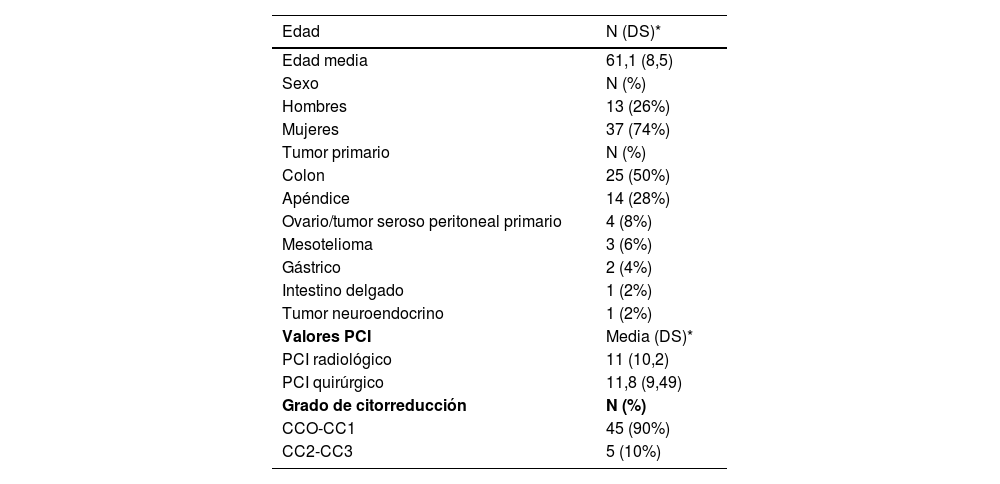Evaluar la precisión de la tomografía computarizada multidetector (TCMD) para la selección de pacientes con carcinomatosis peritoneal (CP) candidatos a cirugía de citorreducción y quimioterapia intraperitoneal hipertérmica (CCR+HIPEC), analizando el grado de correlación entre el PCI (Peritoneal Cancer Index, Índice de Carcinomatosis Peritoneal) radiológico (PCIr) y el PCI quirúrgico (PCIq).
MétodoEstudio observacional, retrospectivo y unicéntrico. Se compara el PCIr calculado mediante TCMD valorada por radiólogos expertos y el PCIq mediante el coeficiente de correlación de concordancia (CCC). Se utilizó el método de Bland-Altman para representar la diferencia entre las dos observaciones frente a su media, con intervalo de confianza (IC) del 95%. Se evaluó si el volumen tumoral afecta al CCC estableciendo un punto de corte del PCIq en 15. Valoramos la sensibilidad y la especificidad del PCIr >20 como predictor de irresecabilidad, tal y como indican las guías clínicas.
ResultadosEn los 50 pacientes intervenidos, el PCIq medio fue 11,8 (9,5) y el PCIr 11,0 (10,2) con un CCC de 0,94 (IC 95% 0,91-0,97). El CCC en los 35 pacientes con PCIq <15 fue de 0,84 (IC 95% 0,72-0,91) y con PCIq≥15 de 0,79 (IC 95% 0,56-0,91). La TCMD como predictor de irresecabilidad para PCIr>20 tuvo una sensibilidad de 0,82 (IC 95% 0,68-0,92) y especificidad de 0,40 (IC 95% 0,05-0,85), el valor predictivo positivo fue de 0,92 (IC 95% 0,80-0,98) y valor predictivo negativo de 0,20 (IC 95% 0,03-0,56).
ConclusiónLa TCMD interpretada por radiólogos expertos es fiable para la selección de pacientes candidatos a CCR+HIPEC, sin considerar exclusivamente el valor de PCIr como contraindicación para el tratamiento completo. Un mayor volumen tumoral implica peor concordancia entre el PCIr y PCIq.
To evaluate the accuracy of multidetector computed tomography (MDCT) to select patients with peritoneal carcinomatosis (PC) as candidates for cytoreductive surgery and hyperthermic intraperitoneal chemotherapy (CRS+HIPEC), through an analysis of the degree of correlation between the radiological (rPCI) and surgical (sPCI) scores in the PC index.
MethodsObservational, retrospective, single-centre study between 1 May 2014 and 31 May 2018. Calculated rPCI assessed by MDCT was compared with the sPCI using the Concordance Correlation Coefficient (CCC). The Bland-Altman method was used to plot the difference between the two observations against their mean with a confidence interval (CI) of 95%. We assessed whether tumour volume affects the CCC by setting a cut-off point of sPCI at 15 and considering a sensitivity and specificity of rPCI> 20 as a predictor of unresectability.
Results50 patients underwent surgery. Mean sPCI was 11.8 (9.5) and rPCI was 11.0 (10.2), with a CCC of 0.94 (95% CI: 0.91–0.97). The CCC in the 35 patients with sPCI 20 had a sensitivity of 0.82 (95% CI: 0.68–0.92) and a specificity of 0.40 (95% CI: 0.05–0.85). The positive predictive value was 0.92 (95% CI: 0.80–0.98), while the negative predictive value was 0.20 (95% CI: 0.03–0.56).
ConclusionMDCT, interpreted by an expert radiologist, is reliable for the selection of patients as candidates for CRS+HIPEC; however, the rPCI value cannot be considered in isolation as a contraindication to full treatment. Greater tumour volume usually leads to a worse concordance between rPCI and sPCI.













